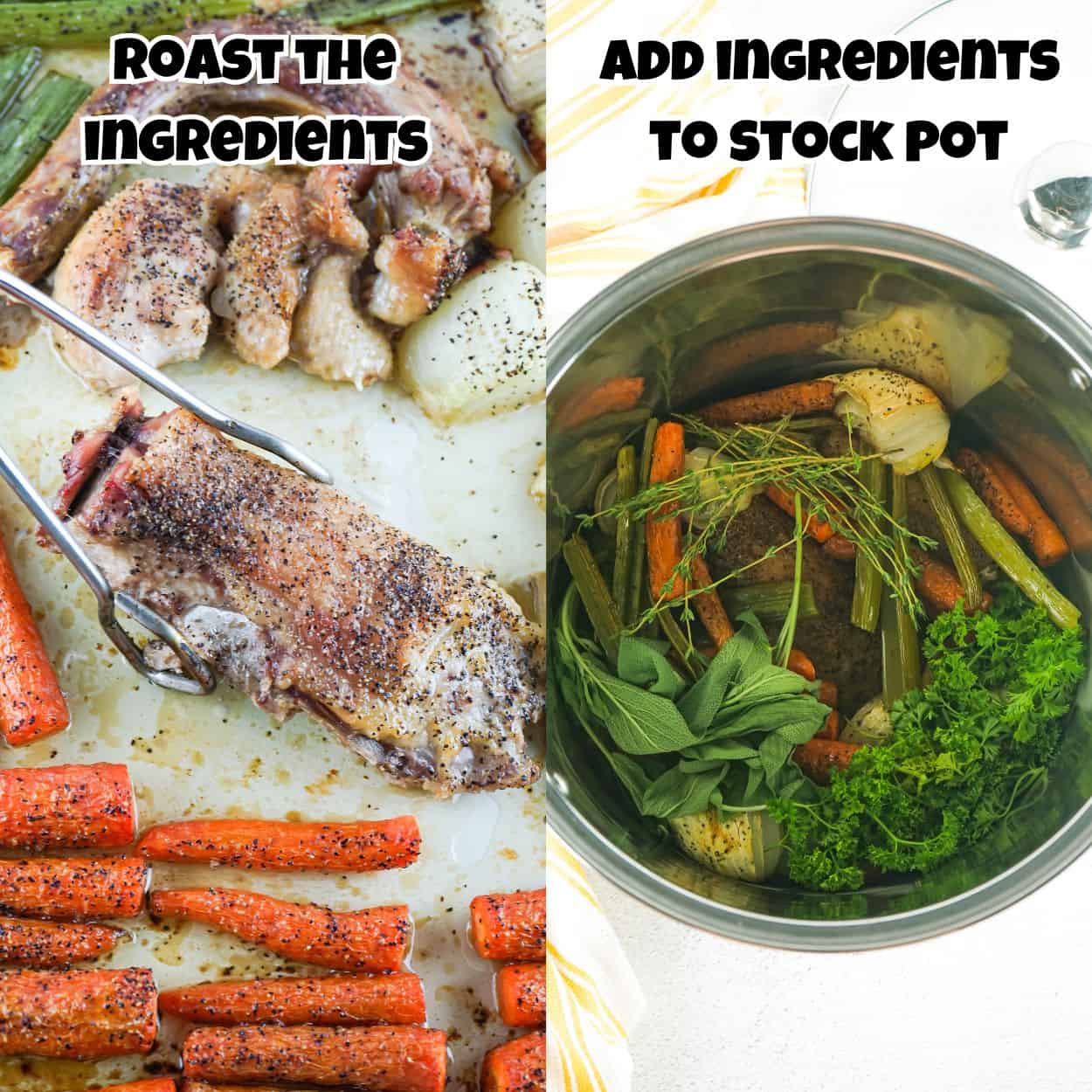Homemade Turkey Broth from Turkey Neck and Carcass

Looking for a way to use up Thanksgiving leftovers? Turkey broth is the perfect solution! With just a few ingredients from your refrigerator and the turkey parts you can create a delicious and aromatic broth that complements a variety of recipes.

This post contains affiliate links. As an Amazon Affiliate, I earn a commission on qualifying purchases.
What do I need to make the Homemade Turkey Broth?
Don't be alarmed if I refer to this as "turkey carcass broth" - that's just what I sometimes call it. Use the leftover neck and other scraps from your Thanksgiving turkey to roast and make the broth. Don't let that turkey carcass intimidate you - embrace it and turn it into something delicious. Here is what you will need to make it.
Ingredients:
- 3 Pounds Raw Turkey
- Carcass from cooked turkey
- 1 ½ Gallons of Water
- 8 Whole Carrots, chopped
- 8 Celery Stalks, chopped
- 2 Onions, quartered
- 2 Cups Fresh Parsley, loosely packed
- 1 Cup Fresh Sage, loosely packed
- 5 Sprigs Fresh Thyme
- Olive Oil
- Salt and Pepper, to taste
Kitchen Items Needed:
- 10-Quart or Larger Stock Pot
- Baking Sheet
- Slotted Spoon
- Tongs
- Cheesecloth

Looking for more delicious recipes? Give these reader favorites a try!
Homemade Turkey Gravy | Herb Butter Turkey | Leftover Turkey Cranberry Sandwich | Kale and Brussels Sprouts Salad with Cranberries |Sweet Potato Casserole with Praline Topping
How do I make the Homemade Turkey Broth?
Step 1: Roast the turkey and vegetables
Preheat the oven to 400 degrees Fahrenheit. Place the raw turkey meat on a baking sheet with carrots, celery, and onions. Brush all the ingredients on the baking sheet with olive oil and sprinkle with salt and pepper. Bake in the center rack of your oven for 45 minutes, then remove from the oven.

Step 2: Simmer the ingredients
Add the roasted ingredients, turkey carcass, thyme, sage, parsley, and water to a stock pot. Be sure to drain the juices from the baking sheet into the pot.
Bring to a boil and then let it simmer in the stock pot for a total cooking time of 3 hours. Check randomly and add water if it has evaporated too much.
Remove from the heat and let it cool until the excess fat has hardened at the top.
Step 3: Drain the liquid through a cheesecloth
Remove the large chunks from the stock using a slotted spoon or tongs and discard as much of the hardened fat as possible. Using a large bowl or container, lay the cheesecloth or the flour sack towel over the bowl and pour the stock in, ensuring the sides don't fall in. Slowly lift all sides of the cloth/towel and let all the liquid drain through it. When it stops draining, slowly squeeze from the top down to get all the liquid out. Avoid squeezing too hard to prevent excess fat from squeezing through.

Would you like to save this?
Step 4: Season and enjoy!
Taste the stock and add more salt or pepper, if desired. Store the stock in a sealed container in the fridge, or use and enjoy!
Homemade Turkey Broth Tips
Enhance Turkey Stock Flavor: Skip the Red Parts
Don't waste time with the red parts of the turkey, like giblets. They won't contribute to the great flavor you're looking for.
Better Results with Overnight Cooling
Give your stock a chance to cool overnight in the fridge. The color may darken a bit, but that only means more flavor.
Avoid Evaporation, Retain Moisture
Keep the heat at a simmer, not too high. You don't want to lose too much water. To keep the moisture cycling back into the pot, simply leave the lid on. Say goodbye to constantly adding water.
Play with Ingredients, No Harm Done
Feel free to experiment with herbs and vegetables. It's hard to go wrong, and if you do, just adjust with a bit more water. The end result will be perfect taste.
Long-lasting Delight: Storage Tips
Keep your stock in an airtight container in the fridge for up to 2 weeks, maybe even longer. Mason jars work great for storage. If you need to freeze it, use an airtight container and it will last 2-3 months. Enjoy the convenience!
Discover the Benefits of Turkey Broth
Looking for a soothing and light option when you're sick or unable to eat solid foods? Look no further than this homemade turkey broth recipe. Packed with vital nutrients, it's a great addition to your diet. Whether you enjoy it alone or in your favorite recipes, turkey broth is a versatile and delicious option.

Enhance Your Recipes with Turkey Broth
Take your dishes to the next level with the flavorful boost of turkey broth. From soups and stuffing to smoked meats and gravy, this tried and true recipe is essential for culinary success. Don't miss out on the opportunity to make your creations super yummy!
Understanding the Difference Between Stock and Broth
Is it turkey stock or turkey broth? There's a slight difference, but it's easy to distinguish. While stock consists of just bones, broth includes added meat. Although they're often used interchangeably, knowing the distinction is good. Expand your culinary knowledge with this helpful chart.

Choosing Between Turkey Stock and Turkey Broth
The debate between stock and broth is a matter of personal preference. While broth offers more flavor, it can sometimes overpower other dishes. On the other hand, stock adds substance to recipes without stealing the spotlight. Decide which option is right for you based on the desired outcome of your dish.
Does Turkey Broth Really Cause Sleepiness?
Contrary to popular belief, it's not the tryptophan in turkey that makes us sleepy on Thanksgiving. Other amino acids in turkey help regulate the effect of tryptophan. While it may play a slight role, sleepiness after a big Thanksgiving meal is often due to carb-heavy foods and fatigue from traveling. However, everyone reacts differently, so why not conduct your science experiment?


Homemade Turkey Broth
Equipment
- 10-Quart or Larger Stock Pot
- Baking Sheet
- Slotted Spoon
- Tongs
- Cheesecloth
Ingredients
- 3 Pounds Raw Turkey
- Turkey Carcass
- 1 ½ Gallons of Water
- 8 Whole Carrots chopped
- 8 Celery Stalks chopped
- 2 Onions quartered
- 2 Cups Fresh Parsley loosely packed
- 1 Cup Fresh Sage loosely packed
- 5 Sprigs Fresh Thyme
- Olive Oil
- Salt and Pepper to taste
Instructions
- Preheat the oven to 400 degrees Fahrenheit.
- Take your raw turkey and place it on the baking sheet along with the carrots, celery, and onions.
- Brush all of the ingredients on the baking sheet with olive oil and sprinkle with salt and pepper.
- Bake for 45 minutes, then remove from the oven.
- Add the roasted ingredients along with the turkey carcass, thyme, sage, parsley, and water to the stock pot. Be sure to drain the juices from the baking sheet, into the pot as well.
- Bring to a boil and then let simmer in the stock pot for a total cooking time of 3 hours.
- Check the pot randomly and add water if it has evaporated too much.
- Remove from the heat and let cool until the excess fat has hardened at the top.
- Using a slotted spoon or tongs, remove the large chunks from the stock and as much of the hardened fat as possible and discard.
- Using a large bowl or container, lay the cheesecloth or the flour sack towel over the bowl and pour the stock in, ensuring the sides of the towel don’t fall in.
- Slowly lift up all sides of the cloth/towel and let all the liquid drain through it and when it stops draining, slowly squeeze from the top down so you get all the liquid out. Don’t squeeze overly hard as you don’t want any excess fat to squeeze through.
- Taste the stock and add more salt or pepper, if desired.
- Store in a sealed container in the fridge or use and enjoy!
Notes
- For a richer taste, feel free to cool your stock overnight in the fridge. It might darken a bit, but it only enhances the flavor.
- Be cautious with the heat; simmering on high can evaporate too much water.
- Keep the lid on during cooking to retain moisture. No need to constantly add water.
- Don't worry about going overboard with herbs or veggies; adjust the taste later by adding a bit of water.
- Store the stock in an airtight container in the fridge for up to 2 weeks. It can also be frozen for 2-3 months for extended use. Mason jars work great for storage.




